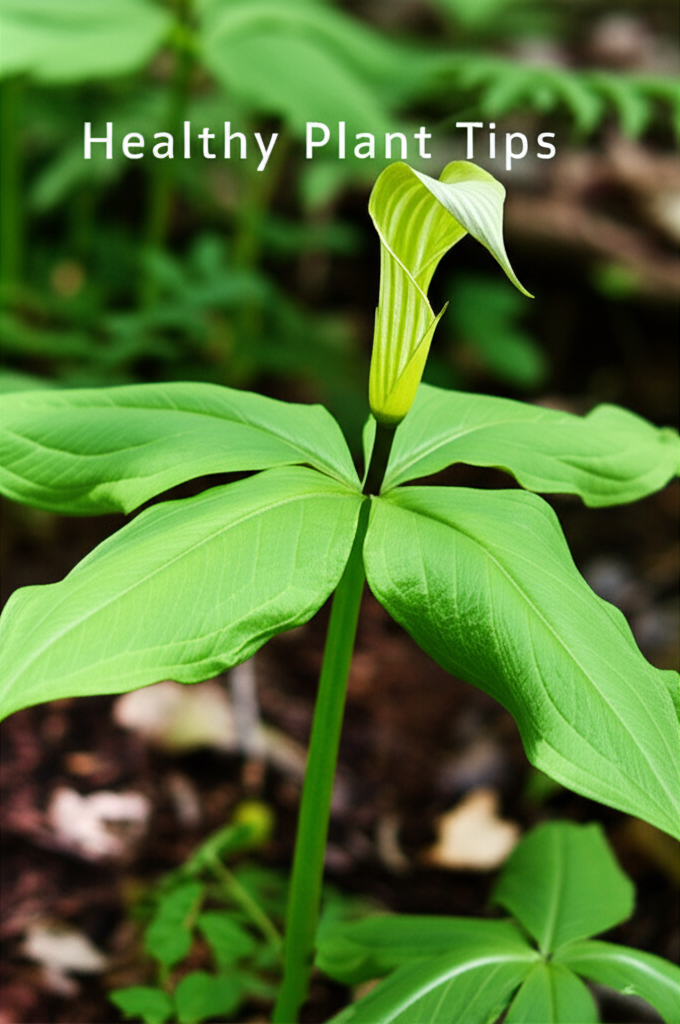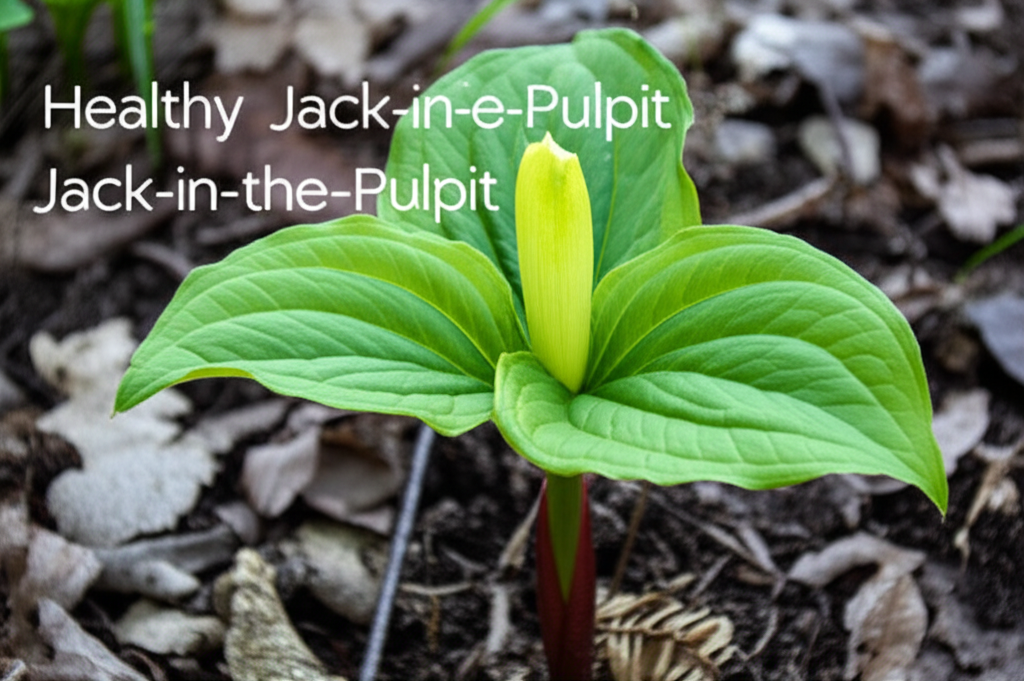Introduction: Understanding Your Arisaema triphyllum
The Jack-in-the-Pulpit (Arisaema triphyllum) is a fascinating and iconic native wildflower of North American woodlands. Its unique spathe and spadix structure, resembling a preacher in a pulpit, has captivated gardeners and nature enthusiasts for generations. While its charm is undeniable, ensuring the health and longevity of this woodland gem requires attentive monitoring. This guide will delve into the essential aspects of Jack-in-the-Pulpit plant health monitoring, empowering you to identify potential issues early and foster a thriving specimen.
Understanding the natural habitat of the Jack-in-the-Pulpit is crucial for effective health monitoring. These plants typically thrive in moist, humus-rich soil, often found on shaded forest floors, along streambanks, and in damp meadows. They are deciduous, meaning they die back to the ground in late summer or fall, storing energy in their underground corms for the following spring. This dormant period is as vital to their health as their active growing season. By recognizing their ecological needs, we can better interpret their visual cues for health.
Key Factors Influencing Jack-in-the-Pulpit Health
Several environmental and biological factors directly impact the well-being of your Jack-in-the-Pulpit. Proactive monitoring of these elements will form the cornerstone of preventing and addressing potential problems.
- Soil Moisture: Consistent, but not waterlogged, moisture is paramount.
- Light Exposure: Dappled shade or partial shade is ideal.
- Soil Composition: Rich, organic, well-draining soil is preferred.
- Pest and Disease Pressure: While generally robust, they can be susceptible to certain issues.
- Cultural Practices: Proper planting depth, mulching, and avoiding disturbance are important.
Visual Inspection: The First Line of Defense

Regular visual inspection is the most straightforward and effective method for monitoring Jack-in-the-Pulpit health. By becoming familiar with what a healthy plant looks like, you can quickly spot deviations that might indicate an underlying problem.
Assessing Foliage: Leaves as Indicators
The leaves of the Jack-in-the-Pulpit are excellent indicators of its overall health.
- Healthy Leaves: Typically, they are a vibrant, deep green, with a smooth texture. The leaflets are usually pointed and well-formed.
- Yellowing Leaves (Chlorosis): This is a common symptom that can arise from several causes.
- Too much sun: Direct sunlight can scorch the leaves, leading to yellowing and browning.
- Poor drainage: Waterlogged soil deprives the roots of oxygen, causing yellowing.
- Nutrient deficiency: Lack of essential nutrients, particularly nitrogen, can manifest as overall leaf yellowing.
- Natural senescence: As the plant prepares for dormancy, its leaves will naturally yellow and die back. Distinguish this from premature yellowing.
- Wilting Leaves: Wilting can be a sign of insufficient water, but also of root rot due to overwatering or compacted soil.
- Brown or Crispy Leaf Edges: This often suggests a lack of moisture, especially during dry spells, or exposure to harsh winds.
- Spots or Lesions: Irregular spots, discoloration, or fuzzy growth on the leaves could indicate fungal or bacterial infections.
Observing the Inflorescence: The “Jack” and “Pulpit”
The unique flower structure, the spathe (the hooded leaf) and spadix (the fleshy spike), also provides valuable clues.
- Healthy Inflorescence: The spathe should be upright, with a distinct hood and a pointed tip. The color can vary from green to purplish-brown, depending on the variety and conditions. The spadix should be firm and erect.
- Wilting or Drooping Spathe: Similar to leaf wilting, this can indicate water stress or root issues.
- Discoloration or Rotting of Spathe/Spadix: Unusual browning, blackening, or a mushy texture suggests a fungal or bacterial attack, often exacerbated by excess moisture and poor air circulation.
- Lack of Inflorescence: If your plant consistently fails to produce a flower, it might be too young, not receiving adequate sunlight or nutrients, or experiencing stress from transplanting or poor growing conditions.
Examining the Corm: The Underground Powerhouse
While not always visible without excavation, understanding the health of the corm is crucial. Signs of corm distress might be inferred from the above-ground symptoms.
- Healthy Corm: A healthy corm is firm, plump, and free of mold or rot.
- Soft or Mushy Corm: This is a clear indication of rot, usually caused by overwatering and poor drainage.
- Shriveled or Dry Corm: This suggests the plant has been severely dehydrated, either due to drought or inadequate watering during its growth or dormancy.
Common Jack-in-the-Pulpit Health Issues and Solutions
By understanding the potential problems, you can take targeted action to restore your plant’s health.
Fungal Diseases
Fungal pathogens can affect Jack-in-the-Pulpits, particularly in humid conditions or when drainage is poor.
- Symptoms: Leaf spots, blights, wilting, and stem rot.
- Causes: Overwatering, poor air circulation, humid environments, contaminated soil.
- Solutions:
- Improve drainage by amending soil with compost and grit.
- Ensure adequate spacing between plants for good air circulation.
- Water at the base of the plant to keep foliage dry.
- Remove and destroy infected plant parts promptly.
- In severe cases, a fungicide might be considered, but focus on cultural controls first.
Bacterial Diseases
Less common than fungal issues, bacterial infections can also impact Jack-in-the-Pulpits.
- Symptoms: Soft rots, wilting, bacterial ooze.
- Causes: Wounding, high humidity, contaminated water.
- Solutions:
- Avoid wounding the plant during maintenance.
- Ensure good hygiene in the garden.
- Remove and destroy infected plants.
- Antibiotics are rarely effective for ornamental plants; prevention is key.
Pest Infestations
While not typically plagued by severe pest issues, some common garden pests can target Jack-in-the-Pulpits.
- Slugs and Snails: These can chew holes in leaves and damage the spathe.
- Solutions: Handpick them, use slug bait (organic options are available), or create barriers.
- Aphids: Small, sap-sucking insects that can cluster on new growth.
- Solutions: Blast them off with water, use insecticidal soap, or encourage beneficial insects.
- Fungus Gnats: Larvae feed on roots and decaying organic matter in overly wet soil.
- Solutions: Allow the soil surface to dry slightly between waterings, use sticky traps, or consider beneficial nematodes.
Environmental Stress
Improper growing conditions are a frequent cause of poor Jack-in-the-Pulpit health.
- Sunburn:
- Cause: Too much direct sunlight, especially afternoon sun.
- Solution: Relocate the plant to a shadier spot or provide overhead cover.
- Drought Stress:
- Cause: Insufficient watering, especially during dry periods.
- Solution: Water deeply and consistently, mulch to retain moisture.
- Waterlogging:
- Cause: Poor drainage, overwatering.
- Solution: Improve soil drainage with amendments, reduce watering frequency.
- Transplant Shock:
- Cause: Disturbing roots during planting or moving.
- Solution: Plant at the correct depth, water well after planting, avoid unnecessary disturbance.
Monitoring Through the Seasons
Effective health monitoring isn’t a one-time event; it’s an ongoing process that adapts to the plant’s seasonal cycle.
Spring: Emergence and Early Growth
As the Jack-in-the-Pulpit emerges from its dormancy, observe for:
- Healthy Emergence: The tightly furled leaves and emerging spathe should appear robust.
- Early Signs of Distress: Any wilting, discoloration, or deformities at this stage can indicate issues with the corm or overwintering conditions.
- Pest Activity: Look for slugs and snails that may emerge with the new growth.
Summer: Peak Growth and Flowering
This is the most visually active period for the Jack-in-the-Pulpit. Monitor:
- Foliage Vigor: Deep green, healthy leaves indicate good health.
- Inflorescence Development: Observe the color, shape, and uprightness of the spathe and spadix.
- Seed Pod Formation: After flowering, bright red berries form, indicating successful pollination. Their health is also a sign of the plant’s vigor.
- Environmental Conditions: Ensure consistent moisture and adequate shade during hot spells.
Late Summer/Fall: Dieback and Dormancy Preparation
As the plant prepares for winter, its leaves will naturally yellow and die back.
- Natural Senescence vs. Problem: Distinguish between the natural process of dying back and premature yellowing or wilting caused by disease or stress.
- Allowing Natural Dieback: Do not cut back the foliage until it has fully yellowed and withered; the plant is drawing nutrients back into the corm.
Winter: Dormancy and Corm Health
During dormancy, the plant is resting underground.
- Soil Moisture: While the plant is dormant, the soil should not be completely dry, especially in milder climates. However, avoid waterlogged conditions that can lead to corm rot.
- Protection: A layer of mulch can protect the corm from extreme temperature fluctuations and prevent heaving.
Key Facts and Comparison of Health Indicators
This table provides a quick reference for identifying common health issues.
| Symptom | Potential Cause(s) | Action(s) Recommended |
|---|---|---|
| Yellowing Leaves | Too much sun, poor drainage, nutrient deficiency, natural senescence | Assess light, check drainage, consider light fertilization, observe if natural dieback |
| Wilting Leaves/Spathe | Drought stress, root rot, fungal infection | Check soil moisture, improve drainage, inspect roots if possible |
| Brown/Crispy Leaf Edges | Drought stress, windburn | Increase watering, provide wind protection |
| Spots/Lesions on Leaves | Fungal or bacterial infection | Improve air circulation, reduce foliage moisture, remove infected parts |
| Soft/Mushy Corm | Root rot due to overwatering/poor drainage | Improve drainage, reduce watering, consider replanting in well-draining soil (if salvageable) |
| Shriveled Corm | Severe dehydration | Increase watering during growing season, ensure adequate moisture during dormancy |
Preventative Measures and Best Practices
The best approach to Jack-in-the-Pulpit health is prevention. Implementing sound horticultural practices will significantly reduce the likelihood of problems.
Table: Steps for Optimal Jack-in-the-Pulpit Health Monitoring and Management
| Step | Description | Pros | Cons |
|---|---|---|---|
| 1. Site Selection | Choose a location with dappled shade, moist, humus-rich, well-draining soil. | Prevents overexposure, promotes healthy root development. | Limited suitable locations in some gardens. |
| 2. Proper Planting Depth | Plant corms 2-4 inches deep with the pointed end up. | Ensures adequate protection and encourages upright growth. | Can be difficult to judge depth accurately. |
| 3. Mulching | Apply a layer of organic mulch (leaf mold, compost) around the plant. | Retains soil moisture, suppresses weeds, regulates soil temperature, protects corm. | Can harbor slugs if applied too close to the crown. |
| 4. Watering Regimen | Water consistently, especially during dry spells, but avoid soggy conditions. | Maintains healthy foliage and corm hydration. | Requires attention, especially during summer heat. |
| 5. Regular Visual Inspections | Periodically examine leaves, spathe, and spadix for any abnormalities. | Early detection of problems, allowing for timely intervention. | Requires consistent effort and keen observation. |
| 6. Air Circulation | Ensure adequate spacing between plants and avoid overcrowding. | Reduces fungal and bacterial disease spread. | May require thinning or strategic planting. |
| 7. Pest Management | Monitor for common pests and address them promptly using appropriate methods. | Protects the plant from damage and stress. | Some treatments may require careful application. |
| 8. Avoid Disturbing Roots | Minimize digging or tilling around established plants. | Prevents damage to the corm and root system. | Requires careful weeding around the plant. |
Conclusion: Cultivating a Thriving Woodland Jewel
Monitoring the health of your Jack-in-the-Pulpit is a rewarding endeavor that deepens your connection with this enchanting native plant. By understanding its natural needs, diligently observing its visual cues, and implementing preventative care, you can ensure your Arisaema triphyllum thrives for years to come. Remember that consistency in observation and a willingness to adapt your care based on the plant’s signals are key to cultivating this beautiful woodland jewel. With attentive monitoring, your Jack-in-the-Pulpit will continue to bring its unique charm and vitality to your garden.


